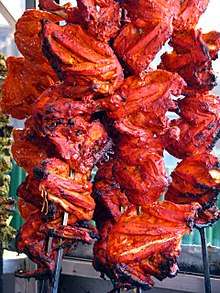Punjabi cuisine
Punjabi cuisine is a culinary style originating in the Punjab, a region in the northern part of the Indian subcontinent, which is now divided in an Indian part and a Pakistani part. This cuisine has a rich tradition of many distinct and local ways of cooking. One is a special form of tandoori cooking that is now famous in other parts of India, UK, Canada, Hong Kong and in many parts of the world.
| Part of a series on the |
| Punjabis |
|---|
 |
|
|
Asia
Europe North America Oceania |
|
Culture |
|
Punjab portal |
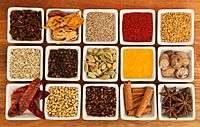 |
| This article is part of the series on |
| Indian cuisine |
|---|
|
Regional cuisines
|
|
Ingredients, types of food
|
|
See also
|
|
Related cuisines |
|
 |
| This article is part of the series |
| Pakistani cuisine پاکستانی پکوان |
|---|
|
Ingredients
|
|
See also
|
|
The local cuisine of Punjab is heavily influenced by the agriculture and farming lifestyle prevalent from the times of the ancient Harappan Civilization. Locally grown staple foods form the major part of the local cuisine. Distinctively Punjabi cuisine is known for its rich, buttery flavours along with the extensive vegetarian and meat dishes. Main dishes include sarhon dā sâg (a stew whose main ingredient is mustard greens) and makki di roti (flatbreads made with cornmeal).
Karrhi is a spicy, yellow gravy with cakes made of chickpea flour (besan), containing lemon juice, red pepper and turmeric. It is commonly served with rice or naan.
Basmati rice is the indigenous variety of Punjab, and various meat- and vegetable-based rice dishes have been developed using it.[1][2][3]
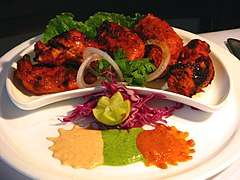
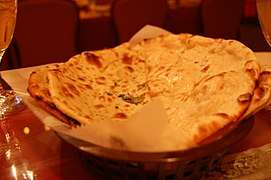
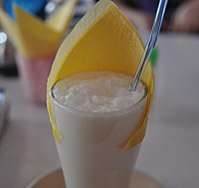
Style of cooking
There are many styles of cooking in Punjab. In the villages many people still employ the traditional infrastructure for cooking purposes. This includes wood-fired and masonry ovens. Modern methods include cooking on gas cookers. Tandoori style of cooking involves use of the tandoor.[4] In India, tandoori cooking is traditionally associated with Punjab[5] as Punjabis embraced the tandoor on a regional level.[6] This style of cooking became popular throughout India after the 1947 partition when Punjabis resettled in places such as Delhi. According to Planalp (1971), "the Panjab-style underground oven known as tandur is becoming increasingly popular in New Delhi" pointing to the Punjabi style of the tandoor.[7][8] In rural Punjab, it is common to have communal tandoors,[9][10] which are also called Kath tadoors in Punjabi.
Staple foods
Punjab is a major producer of wheat, rice and dairy products. These products also form the staple diet of the Punjabi people. The state of Punjab has one of the highest capita usage of dairy products in India.[11] Therefore, dairy products form an important component of Punjabi diet.
Dairy products
Dairy products are a staple in Punjabi cuisine.[12] Both cow milk and water buffalo milk are popular. Milk is used for drinking, to add to tea or coffee, to make homemade dahi (yogurt), for butter and making traditional Punjabi cottage cheese called paneer.[13]Traditionally, yogurt is made every day using previous day's yogurt as the starting bacterial culture to ferment the milk. The Dahee is used as dressing for many raita dishes,to prepare Kadhi, to prepare cultured buttermilk (Chaas), and as a side dish in a meal.[14] Buttermilk is used in making various kinds of Lassi.[15][16][17] It may also be used in curry preparations.[18] Milk is also the prerequisite ingredient for butter and Ghee (clarified butter).
Food additives and condiments
Food additives and condiments are usually added to enhance the flavor of the food. Food coloring as additive is used in sweet dishes and desserts. Starch is used as a bulking agent.
Common dishes
Breakfast

Breakfast recipes with respect to different regions within Punjab varies. Common ones are chana masala, chole kulche, aloo paratha, panner paratha, gobi paratha, paratha with curd, halwa poori,[19] bhatoora, falooda, makhni doodh, Amritsari lassi, masala chai, tea, Amritsari kulchas, dahi vada, dahi, khoa, paya, aloo paratha with butter, panjeeri with milk.
In the upper Punjab Pakistan the Lahori Katlama is famous for breakfast as well.[20]
Meat
Poultry, lamb and goat meat are the preferred meat sources in different regions of Punjab.
Many dishes of meat variety is available and some of them are named below.
- Biryani:[21] lamb and chicken
- Kebab: braised chicken or lamb meat, commonly served with naan and flat bread.
- Keema: Braised minced lamb meat, commonly served with naan.
- Lamb: including rogan josh, Bhuna Gosht,[21] Kadhai Gosht, Raan Gosht, Dal Gosht, Saag Gosht, Nihari, Rara Gosht, Paye da Shorba
- Shami kebab, chicken karahi, Amritsari tandoori chicken,[21] Punjabi Karhi (the chicken yogurt curry of Punjab),[22] Butter Chicken (Murgh Makhni),[21] chicken tikka, Paye.
- Kunna Gosht, slow cooked meat prepared in Kunna (mitti ki bartan (clay utensil))
- Haleem is made of meat (beef or chicken) slow cooked with a mixture of legumes softened by overnight cooking it is a protein rich food with spices and aromatics like nutmeg served with wedge of lemon and sautéed onions.
Fish
Since Punjab is a landlocked region, freshwater fish, and not marine fish, forms an important part of the cuisine.[23] Carp, rohu and catfish are the most commonly prepared fish. Other fish types include thela machi and tilapia. Recently shrimp has been introduced.[24] Fish tikka is an Amritsari speciality.[21]
Vegetarian
.jpg)
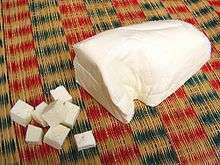
- Khichdi, a grain-and-lentil dish:[25] In the Punjab, khichdi is made of millet flour, mung beans and moth lentils (Vigna aconitifolia). However, khichdi made of rice and red lentils or mung beans is also consumed.
- Paneer (freshly made cottage cheese) Recipes like Shahi Paneer; Khoya Paneer, Paneer Kofta (paneer chunks battered and fried, then simmered in a spicy gravy), Amritsari Paneer, Matar Paneer (paneer with green peas), paneer paratha (wheat flatbread stuffed with paneer),Palak Paneer
- Panjiri: This is a traditional Punjabi dessert dish[26] which has a generous amount of almonds, walnuts, pistachios, dry dates, cashew nuts along with whole wheat flour, sugar, edible gum, poppy seeds and fennel seeds to make the traditional dish of 'panjri' or also known as 'dabra'.
- Legumes: a variety of legumes are used, including chickpeas, pigeon peas, red lentils, mung bean, red kidney beans (originally an import from the Americas) and black gram. Legumes may be used singly or in combination.[27][28][29][30]
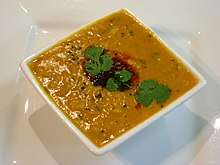 Tarka daal ambarsari
Tarka daal ambarsari - Saag: a variety of leafy greens (including spinach and mustard greens), typically cooked down to a stew, seasoned with ginger, garlic, chilies and other spices, and often enriched with paneer or cream. Bathua is also added to enhance the flavor. It is served with butter on top and with makki ki roti. Saag is a winter and spring delicacy; it is one of the most popular dishes of Punjab.
- Eggplant: Baingan bharta is similar to baba ghanoush in the way the eggplant is prepared by roasting and peeling the skin off, but much richer, with the incorporation of much cooked tomato, browned onion and a variety of spices instead of tahini.[31]
- Punj Ratani Dal:[21] A thick gravy that uses 5 legumes, with tomato, browned onion and spices.
- Punjabi Kadhi Pakora (traditional curry with rice. Kadhi is a type of curry made with yogurt or buttermilk, which is thickened with chickpea flour and seasoned with ginger, turmeric, chilies, and tempered spices. Deep-fried lumps of spiced chickpea-flour batter (pakoras) are also added.
- Punjabi Lassi paneer: In the Punjab, it is traditional to prepare lassi and then extract the paneer which would then be consumed by adding water, salt and chili. Lassi paneer can also be added to potatoes and spices to make a curry which resembles scrambled eggs. Lassi paneer cannot be cut into cubes as paneer from milk can be.[25]
Snacks
- Toasted grains: In Punjab, toasting corn and wheat grains on the Punjabi bhathi is a traditional delicacy.[25]
- Samosas.
Raita and chutney
Along with all types of main dishes chutney is also served.
Sweets and desserts
Punjabi cuisine includes various types of desserts and Mithyai which include:
Bread
Punjabis eat a variety of breads. Flatbreads and raised breads are eaten on a daily basis. Raised breads are known as khamiri roti. Sunflower and flax seeds are also added in some breads occasionally. The breads may be made of different types of flour and can be made in various ways:
- Baked in the tandoor like naan,[21] tandoori roti,[21] kulcha,[21] or lachha paratha[21]
- Dry baked (Indian griddle), jowar ki roti, baajre ki roti and makki ki roti (these are also smeared with white butter)
- Shallow fried like paratha[35]
- Deep fried like puri,[21] Kachori[36] and bhatoora[21] (a fermented dough)
- Salt-rising bread: Salt rising bread is a unique bread found only in the Salt Range region of Punjab, Pakistan. Since rock salt is readily available in salt range so many people in the past made use of salt instead of yeast to leaven the bread.
- Papar
Herbs and spices

Indian subcontinent based spices are used in Punjabi cuisine which are ground in the Mortar and pestle or the food processor.
Beverages
Punjab has a diverse range of beverages. Some are dairy-based such as lassi and butter milk. Water buffalo milk-based products are especially common around Punjab.[37] Examples are mango lassi,[38][39] mango milkshake,[40][41] and chaas.[42][43] Others are juices derived from vegetables and fruits, such as watermelon shakes,[44] carrot juice and tamarind juice (imli ka paani). Shikanjvi and neembu paani drinks are especially preferred during the summer. Jal-jeera is also common as well.
Sattu is a traditional North Indian drink which is also traditionally consumed in the Punjab. Sattu is made by roasting barley grains and then grinding them into powder, mixed with salt and turmeric and water.[25]
The local regional drinks in Punjab also include Doodh soda (milk soda) and Bantay (local soda drink) in Pakistan.
Fermented foods
Fermented foods are common in Punjabi cuisine. Also fermented foods are added in the preparation of some dishes as well.[45] Mango pickle is especially famous in many villages of Punjab.[46][47]
Cooking methods
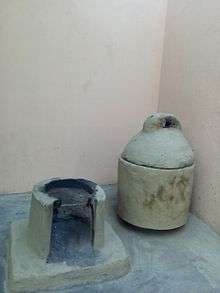
Traditional and modern methods are employed for cooking Punjabi cuisine. The traditional stoves and ovens used to cook Punjabi food include:
Chullah
The traditional name of the stove in the Punjabi language is chulla.[48] Traditional houses also have ovens (wadda chulla or band chulla) that are made from bricks, stones, and in many cases clay. Older communities in Punjab also used earth ovens (khadda chulla), but this tradition is dying out now.
Bhathi
A masonry oven is known as a bhathi. Outdoor cooking and grilling have many different types of bhathi. A bhathi is used to roast wheat or corn for which Kalsi (1992) describes as a "special oven with an open pan in which sand is heated to roast corn."[49]
Hara
A hara is a six-foot-tall oven with its own roof. The hara is traditionally used to slow-heat milk or slow-cook pulses such as chickpeas.[50]
Tandoor
According to Ahmed (2014), Harappan oven structures may have operated in a similar manner to the modern tandoors of the Punjab.[51] The tandoor is traditionally made of clay and is a bell-shaped oven, set into the earth and fired with wood or charcoal reaching high temperatures. According to Hayter (1992) the original versions of the tandoor "in the Punjab, a province in the north-west of India, were sunk neck deep in the ground". He further states that modern versions can also rest above the ground.[52]
Modern methods
- Pressure cookers
- Iron griddle
Canning, bottling and smoking
Canning and bottling for preservation purpose is a common practice in houses. It increase the longevity of the food products for many months. Also in the old infrastructure smoke houses are a common occurrence that are used for smoking the meat products that increase the shelf life of the meat and also add taste in it as well. Smoked meat is known as bhaapi gosht as well.
Etiquette of Punjabi dining
Etiquette of eating is considered a major part of the cuisine. Every Punjabi household follows certain regional etiquette. The word etiquette has many local names depending on the particular region of Punjab. Though certain etiquette varies regionally, there are many etiquette practices that are common throughout Punjab. Communal dining is a norm in Punjabi families.
Bringing and sending fresh fruits, sweets and food items as gifts to family members is a common practice in Punjab, particularly during the spring season. Food items are distributed among neighbors as well on special occasions and as a sign to show hospitality. Mango is considered a delicacy and produced widely in Punjab,[53] and mango parties are common during the fruit's harvest season. Watermelon and radish at food stalls are shared among friends and relatives.
Major features of etiquette
Invitation to dine
- Invitation to a meal or tea is generally distributed few days beforehand.
- Denying the invitation for no major reason is considered a breach of etiquette.
Table manners
- The invited guest or elder person is given special respect and attention.
- Usually the invited guest is requested to start the meal. It is considered rude if the host starts eating without taking into account the attendance of all guests.
- Table setting is done before the arrival of the guests.
- Family members or any occupants within one home make sure to eat together during the dinner.
- If any other person is present in the vicinity then they are offered meals as a way of giving respect. It is considered rude to start eating food without asking others to participate in a meal. It is customary to offer food to anyone in your vicinity before eating.
- Chewing food with one's mouth open and burping in front of others is considered rude.
- In the villages of Punjab, an additional common plate is usually placed on the table for any bones left from the consumption of bone meat. Placing left overs on the floor or on the table floor is considered bad etiquette.
Eating utensil etiquette
- Punjabi families use a hybrid style of South Asian and European utensil etiquette most of the times. The bread is eaten with the hands. Rice and desserts are eaten with spoons. Soup spoons are used for consuming soup and forks are used for eating noodles.
Punjabi dhaba
The road side is suburban eatery centres. It is also a communal place to sit and chat. Some serve on the same concept of greasy spoon.
Punjabi Restaurants
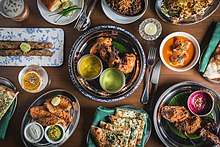
Punjabi cuisine has spread internationally. Notably, Punjab in London has been family-run since 1946. The restaurant is the UK's oldest North Indian restaurant.[55] The New Punjab Club,[56] located in Hong Kong, became the world's first Punjabi restaurant to earn One Michelin Star in 2019.[57]
References
- "Jeera Rice Recipe". Indianfoodforever. Indian food forever.
- "KADHI CHAWAL RECIPE". Indianfoodforever.
- "Punjabi Pulao Biryani". Khanapakana.
- "Metro Plus Delhi / Food : A plateful of grain". Chennai, India: The Hindu. 24 November 2008. Retrieved 7 May 2009.
- The Rough Guide to Rajasthan, Delhi and Agra By Daniel Jacobs, Gavin Thomas
- "What is Mughalai Cuisine?". Archived from the original on 10 October 2013. Retrieved 30 November 2014.
- Planalp, Jack M. (1971) Heat Stress and Culture in North India. U.S. Army Medical Research and Development Command,
- Raichlen, Steven (10 May 2011). "A Tandoor Oven Brings India's Heat to the Backyard". Retrieved 19 March 2017 – via NYTimes.com.
- "Alop Ho Reha Punjabi Virsa Harkesh Singh Kehal".
- Pind Diyan Gallian PTC Channel - Bilga (Jalandhar)
- Times of India 30 06 2014 "Punjab records highest per capita milk availability: Report". Times of India. 30 June 2014. Retrieved 29 August 2014.
- Richard Hosking (2006). Authenticity in the Kitchen: Proceedings of the Oxford Symposium on Food and Cookery 2005. Oxford Symposium. pp. 391–. ISBN 978-1-903018-47-7.
- Richard Hosking (2006). Authenticity in the Kitchen: Proceedings of the Oxford Symposium on Food and Cookery 2005. Oxford Symposium. p. 3917. ISBN 978-1-903018-47-7.
- Misra, R., 2011. Indian Foods: AAPI’s Guide Indian Foods: AAPI’s Guide To Nutrition, Health and Diabetes page 46.
- Anoop Misra (5 July 2012). Dietary Considerations in Diabetes - ECAB. Elsevier Health Sciences. p. 79. ISBN 81-312-3209-3.
- Kaur, K., 2004. Postmodernity and Popular Culture in Amritsar'. Indian Social Science Review, 6(1), pp.107-34.
- John Shi; Chi-Tang Ho; Fereidoon Shahidi (21 October 2010). Functional Foods of the East. CRC Press. pp. 58–60. ISBN 978-1-4200-7193-1.
- Yildiz, edited by Fatih (2010). Development and manufacture of yogurt and other functional dairy products. Boca Raton, FL: CRC Press/Taylor & Francis. p. 11. ISBN 978-1-4200-8207-4. Retrieved 23 May 2016.CS1 maint: extra text: authors list (link)
- khana pakana : Halwa Puri
- "Lahori Katlama Recipe". kfoods.com.
- Know your state Punjab by gurkirat Singh and Anil Mittal Airhunt Publications ISBN 978-9350947555
- "Punjabi Kadhi – ShowMeTheCurry.com". Retrieved 19 March 2017.
- "A Fishing Trip to Pakistan – Punjab (Part 1)". 20 May 2011. Retrieved 19 March 2017.
- Vijay C Roy (30 July 2014). "New tech gives a boost to shrimp farming in Punjab & Haryana". Retrieved 21 December 2014.
- Alop ho riha Punjabi virsa by Harkesh Singh Kehal Pub Lokgeet Parkashan ISBN 81-7142-869-X
- Rani Devalla. "Traditional Punjabi dish for pregnant women". The Hindu. Retrieved 21 December 2014.
- "Punjabi Dal Tadka recipe - Tarka Daal Fry with Masoor Recipe - Chef In You". Retrieved 21 December 2014.
- "moong dal tadka recipe, how to make moong dal recipe". 2 May 2013. Retrieved 19 March 2017.
- "Masoor Dal Recipe, How to Make Whole Massor Dal or Sabut Masoor Dal". Veg Recipes of India. 23 May 2017. Retrieved 29 July 2017.
- Maah Daal : Maah Daal
- Petrina Verma Sarkar. "Baingan Ka Bharta - Seasoned Roast Eggplant". About. Retrieved 21 December 2014.
- "Mawa/Khoya". Flavours on Plate. 11 December 2018. Retrieved 17 February 2020.
- "Rabri". Flavours on Plate. 4 December 2018. Retrieved 17 February 2020.
- "Suji Ka Halwa". food.ndtv.com. Retrieved 21 December 2014.
- "Palak Paratha recipe". Flavours on Plate. 8 February 2019. Retrieved 17 February 2020.
- "Matar kachori". Flavours on Plate. 24 October 2018. Retrieved 17 February 2020.
- "lassi recipe, sweet punjabi lassi recipe - how to make sweet lassi recipe". 30 May 2012. Retrieved 19 March 2017.
- "Mango Lassi". Simply Recipes. 10 November 2006. Retrieved 21 December 2014.
- "BBC - Food - Recipes : Mango lassi". Retrieved 21 December 2014.
- Mango Milkshake :Mango Milkshake
- Mango Milkshake : Mango Milkshake
- "chaas recipe or buttermilk recipe, how to make salted chaas recipe". 22 March 2014. Retrieved 19 March 2017.
- dassana amit. "pudina chaas recipe, how to make pudina chaas - flavored buttermilk". Veg Recipes of India. Retrieved 21 December 2014.
- "Watermelon Juice Recipe, How to Make Watermelon Juice Recipe". Veg Recipes of India. 10 April 2017. Retrieved 29 July 2017.
- Gobhi achar : Punjabi Mix Vegetable Pickle Recipe Archived 27 April 2015 at the Wayback Machine
- Mango pickle :Mango Pickle Recipe
- Mango Pickle recipe : Mango Pickle Recipe
- Asian Perspectives, Volume 42 (2003) University Press of Hawaii
- Kalsi, Sewa Singh (1992) The evolution of a sikh community in Britain: religious and social change among the sikhs of Leeds and Bradford. Community Religions Project Department of Theology and Religious Studies, University of Leeds
- Sidhu Brard, Gurnam Singh (2007) East of Indus: My Memories of Old Punjab. Hemkunt Press
- Ahmed, Mukhtar (2014) Ancient Pakistan - An Archaeological History: Volume IV: Harappan Civilization - Theoretical and the Abstract. Amazon.
- Hayter, Roy (1992) Food Preparation and Cooking: Levels 1 & 2. Macmillan International Higher Education,
- "Mangoes |TRTA Pakistan". Retrieved 29 July 2017.
- "First impressions of New Punjab Club, Central – palatable Indian food". South China Morning Post. 18 October 2017. Retrieved 9 July 2019.
- "Welcome to Punjab". www.punjab.co.uk. Retrieved 9 July 2019.
- "New Punjab Club". newpunjabclub.com. Retrieved 9 July 2019.
- "New Punjab Club – a MICHELIN Guide Restaurant in Hong Kong". MICHELIN Guide. Retrieved 9 July 2019.
External links
| Wikimedia Commons has media related to Cuisine of Punjab, India. |
- Punjabi Food. Cultural India and Pakistan
[https://www.foodkhabari.com/2020/07/shahi-paneer-recipshow-to-make-shahi.html how to make punjab style shahi paneer
